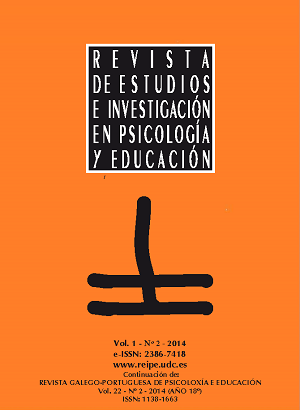An analysis of school failure on two secondary schools
DOI:
https://doi.org/10.17979/reipe.2014.1.2.8Keywords:
secondary compulsory education, school failure, public policy evaluation, educational assessment, school graduationAbstract
Objectives: This study investigates the causes of school failure in two public secondary schools in Padrón (A Coruña, Galicia, Spain) measures programs and policies implemented for reduction. Method: To address the problem of school failure in the centers studied, with an evaluation study mixed methodological approach is designed. In this design the three main objectives of the LOGSE are measured: 1) compulsory education, 2) equity and equal opportunities, 3) and the quality of education. To do this a number of variables through which to benchmark the efficiency, effectiveness, and sustainability excellence are chosen, and quantitative data from various sources and qualitative data collected through interviews and focus groups. Results: We observed that the increase of schooling to 18 years has been one of the positive consequences of the implementation of LOGSE because it is a mechanism that significantly promotes equal opportunities, although the results in terms cultural and educational level, still appear to be insufficient. The factors that influence school failure are multiple and are closely interrelated, so that instead of focusing resources on some of its components, seem to be more appropriate and more likely to succeed a strategy that implies a global approach to the problem.Downloads
Publication Facts
Reviewer profiles N/A
Author statements
Indexed in
-
—
- Academic society
- N/A
- Publisher
- Universidade da Coruña, Servizo de Publicacións
References
Álvarez Méndez, J.M. (1986). Métodos y técnicas de evaluación desde la perspectiva cualitativa. En: J. Calvo de Mora y F. Torrente (coords.), Teoría y práctica de la evaluación en enseñanzas medias (pp. 85-132). Granada: Universidad de Granada, Instituto de Ciencias de la Educación.
Angulo, J.F. (1992). El caballo de Troya. Calidad de la enseñanza y tecnocracia. Cuadernos de Pedagogía, 206, 62-67. http://www.academia.edu/4163636/El_caballo_de_Troya._Calidad_de_ensenanza_y_Tecnocracia
Beltrán, M. (1994). Cinco vías de acceso a la realidad social. En M. García, J. Ibáñez y F. Alvira (coords.), El análisis de la realidad social (pp. 19-50). Madrid: Alianza.
Besse, J. (2000). Los dilemas de Jano. El rol, la posición y la disposición del investigador en la práctica de evaluación de impacto de políticas a través métodos y técnicas cualitativas. Gestión y Política Pública, IX(1), 5-38. http://www.gestionypoliticapublica.cide.edu/num_anteriores/Vol.IX_No.I_1ersem/BJ_Vol.9_No.I_1sem.pdf
Bryk, A. y K. Hermanson (1994). Observations on the structure, interpretation and use of education indicator systems. En: CERI: Making Education Count. Developing and Using International Indicators (pp. 37-53). Paris: Centre for Educational Research and Innovation – OECD. http://www.files.eric.ed.gov/fulltext/ED411322.pdf#page=36
Cernadas, A. (2009). El uso de la metodología cualitativa como técnica de investigación social y como herramienta útil para evaluar la acción de los gobernantes y la satisfacción de los ciudadanos. Administración & Ciudadanía, 4(1), 43-61. http://www.egap.xunta.es/Documentos/Publicacions/%5B1297937171%5DVOL4.1_GAL.pdf
Comisión Europea (1997). Las cifras clave de la educación en la Unión Europea, 1997. Luxemburgo: Oficina de Publicaciones Oficiales de las Comunidades Europeas.
Comisión Europea (1999). El Nuevo Período de Programación 2000-2006: Documentos de trabajo metodológicos, Documento de trabajo 3, Indicadores de Seguimiento y Evaluación: Orientaciones metodoló-gicas. http://www.ec.europa.eu/regional_policy/sources/docoffic/working/doc/indic_es.pdf .
Fernández-Ballesteros, R. (1995). Evaluación de programas: una guía práctica en ámbitos sociales, educativos y de salud. Madrid, Síntesis.
Guerra, M. A. (1990). Hacer visible lo cuotidiano. Teoría y práctica de la evaluación cualitativa de centros escolares. Madrid: Akal.
INCE (2001). Sistema estatal de indicadores de la educación 2000. Madrid: Ministerio de Educación, Cultura y Deportes. http://www.mecd.gob.es/dctm/ievaluacion/indicadores-educativos/ind2000.pdf?documentId=0901e72b8011107e
Íñiguez, L. (1999). Investigación y evaluación cualitativa: bases teóricas y conceptuales. Atención Primaria, 23(8), 496-502. http://www.201.147.150.252:8080/xmlui/bitstream/handle/123456789/1262/Investigao_e_evoluo.pdf?sequence=1
Martínez García, J.S. (2007). Fracaso escolar, clase social y política educativa. El Viejo Topo, 238, 44-49. http://www.abjoves.es/publicaciones/martinez-garcia-j-s-2007-fracaso-escolar-clase-social-y-politica-educativa-viejo-topo-no-238-pp-44-49/
Oakes, J. (1986). Educational Indicators: a guide for policymakers. Santa Monica, CA: RAND Corporation.
OECD (1996). Evaluating and reforming education systems. Paris: OECD.
Ortí, A. (1988). La apertura y el enfoque cualitativo o estructural: la entrevista abierta semidirectiva y la discusión en grupo. En M. García, J. Ibáñez y F. Alvira (coords.), El análisis de la realidad social (pp. 219-283). Madrid: Alianza.
Patton, M. Q. (1990). Qualitative Evaluation and Research Methods. London: Sage.
Sabirón, F. (1990). Evaluación de centros docentes. Modelo, aplicaciones y guía. Zaragoza: Central de Ediciones.
Tiana, A. (1996). La evaluación de los sistemas educativos. Revista Iberoamericana de Educación de la OEI, 10, 37-61. http://www.rieoei.org/oeivirt/rie10a02.htm
Trinidad, A. (1995). La evaluación de instituciones educativas. Granada, Universidad de Granada.
Downloads
Published
How to Cite
Issue
Section
License
The papers published in this journal are licensed under a Creative Commons Attribution-ShareAlike 4.0 International License.
Authors are the holders of the exploitation rights (copyright) of their work, but grant the right of first publication to the Revista de Estudios e Investigación en Psicología y Educación, which may publish in any language and format as well as publish and distribute their whole or partial content by any technologically available means and via data base.
Authors are allowed and encouraged to disseminate the articles accepted for publication on personal or institutional websites, before and after their publication, provided it is clearly stated that the work is in this journal and all bibliographic data are provided along with access to the document, preferably through the DOI (if it is indispensable to use a pdf, the final version formatted by the journal should be used). In the case of articles resulting from funded studies or projects, this will be done within the deadlines and terms established by the supporting organisation(s) of the published research.




